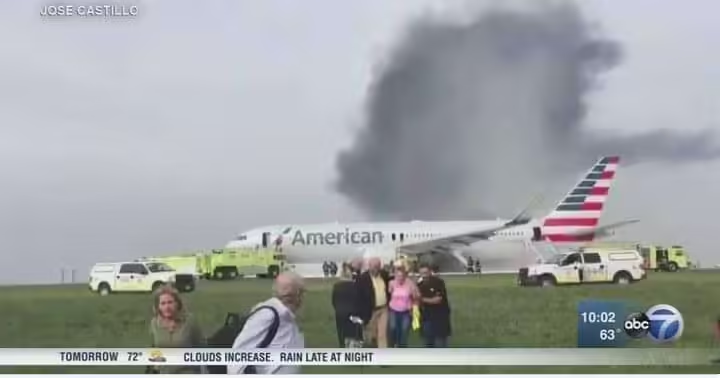A dramatic incident unfolded at Chicago’s O’Hare International Airport when a plane caught fire following an “uncontained” engine failure, resulting in injuries to 20 passengers. The incident, which occurred on a typically routine flight, quickly turned into a terrifying experience for those onboard as well as those on the ground.
The flight in question was American Airlines Flight 383, bound for Miami. Shortly after the plane began its takeoff roll, passengers heard a loud boom, which was followed by flames and thick smoke billowing from the right engine. The cause was later identified as an uncontained engine failure—a rare but severe type of malfunction where internal engine components breach the engine casing, potentially leading to catastrophic outcomes.
As the fire raged, the pilot immediately aborted the takeoff, bringing the aircraft to a halt on the runway. The crew quickly initiated an emergency evacuation, deploying the inflatable slides to get passengers off the plane as swiftly as possible. The entire event, from the initial engine failure to the successful evacuation, unfolded in a matter of minutes.
Emergency responders were on the scene almost immediately, dousing the flames and assisting passengers as they exited the aircraft. Despite the chaos, the evacuation was executed with remarkable efficiency. However, the incident was not without casualties. Twenty passengers sustained injuries, primarily due to smoke inhalation and minor burns. Some of the injuries also resulted from the high-speed evacuation, as passengers scrambled to get off the plane in a hurry.
The National Transportation Safety Board (NTSB) swiftly launched an investigation into the incident. Early findings suggest that a high-pressure turbine disk in the engine failed, causing debris to rupture the engine casing and ignite the fuel. This type of failure, though exceedingly rare, is considered extremely dangerous because of the potential for debris to damage other parts of the aircraft, including the fuel tanks or the fuselage itself.
This incident at O’Hare serves as a stark reminder of the inherent risks associated with air travel, even though flying is statistically the safest mode of transportation. The aviation industry places a significant emphasis on safety, and incidents like these are meticulously studied to prevent future occurrences. The uncontained engine failure at O’Hare will likely lead to a thorough review of the affected engine model, which could prompt changes in maintenance procedures or even design modifications.
For the passengers of Flight 383, the experience was undoubtedly harrowing, yet it also highlighted the importance of emergency preparedness. The swift actions of the flight crew, combined with the quick response of emergency personnel, undoubtedly prevented a far worse outcome.
In the aftermath, American Airlines issued a statement expressing their concern for the injured passengers and pledging full cooperation with the NTSB investigation. The airline also commended the actions of the flight crew, whose professionalism under extreme pressure likely saved lives.
As the investigation continues, the incident at O’Hare will be closely examined by the aviation community, serving as a case study in emergency response and engine safety. For the passengers and crew of Flight 383, it will remain an indelible memory, a stark reminder of the thin line between routine and disaster in air travel.
